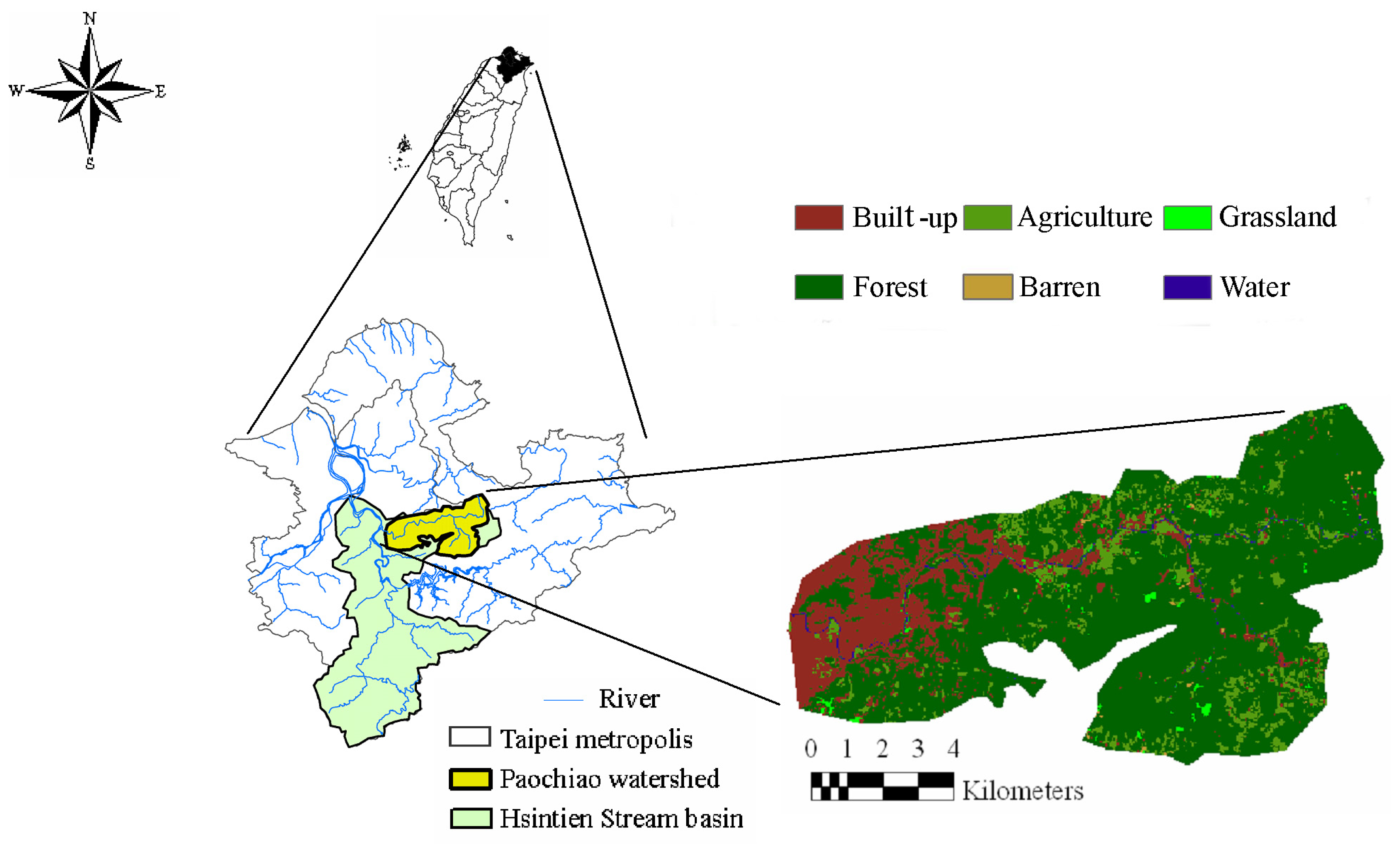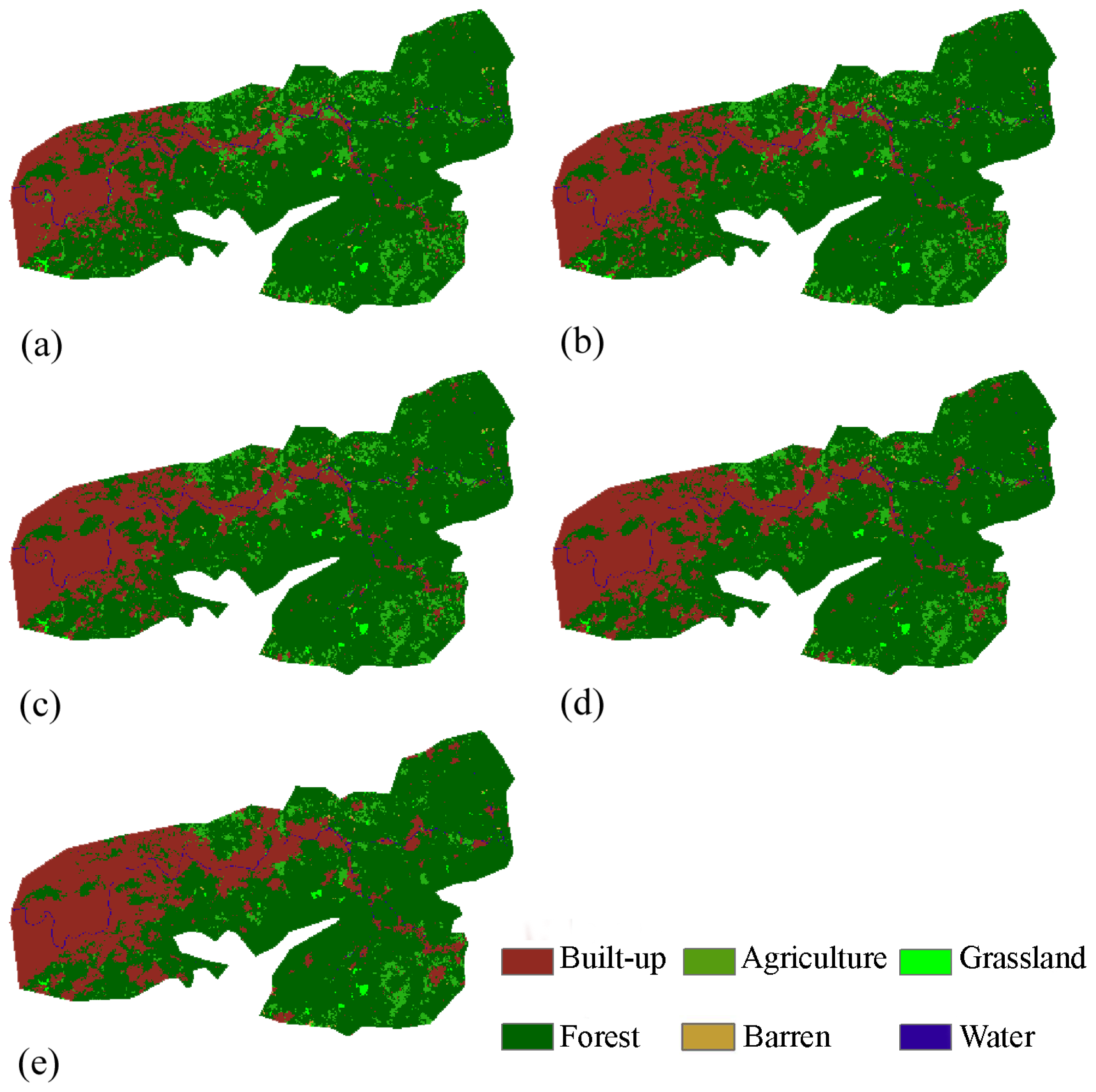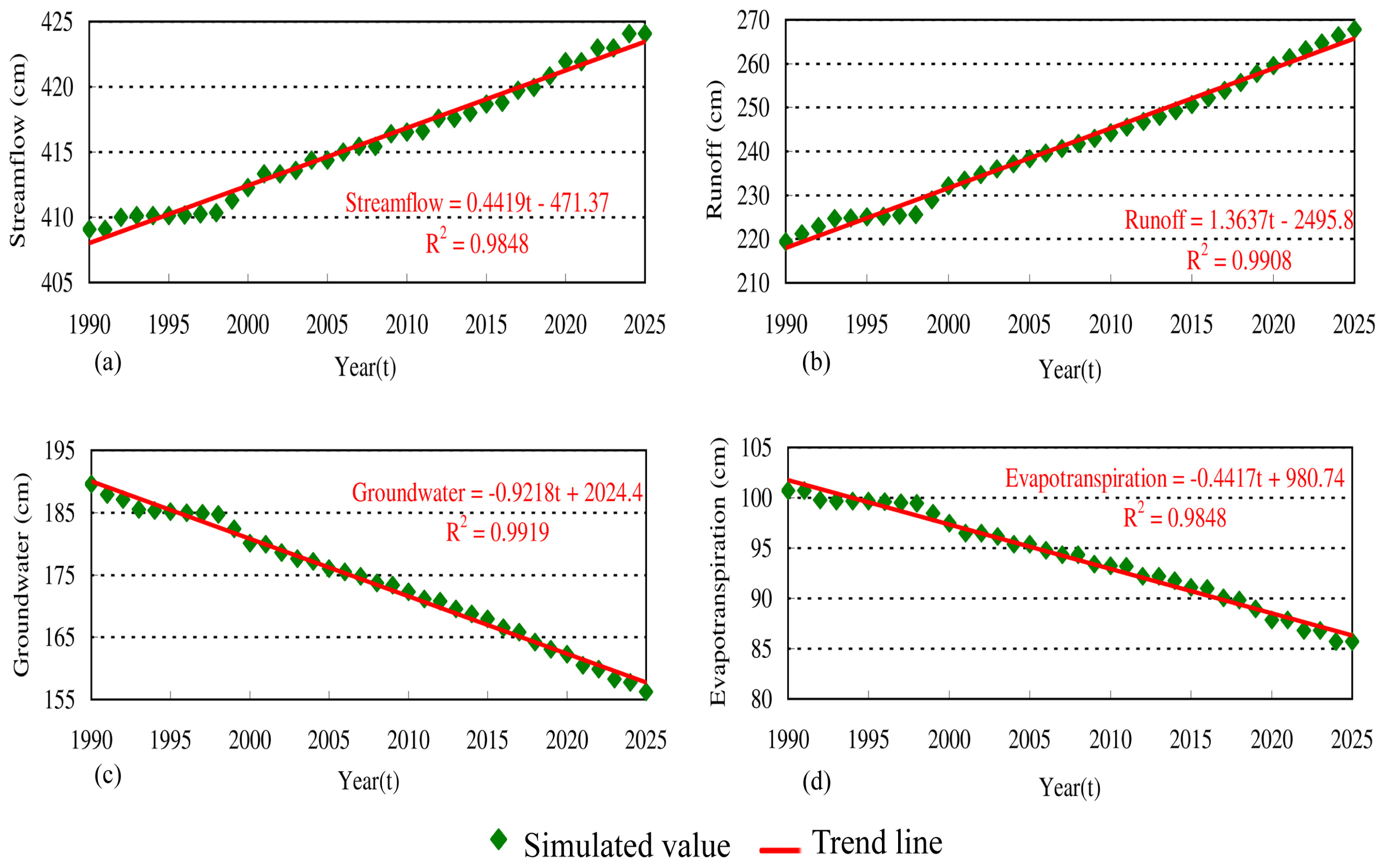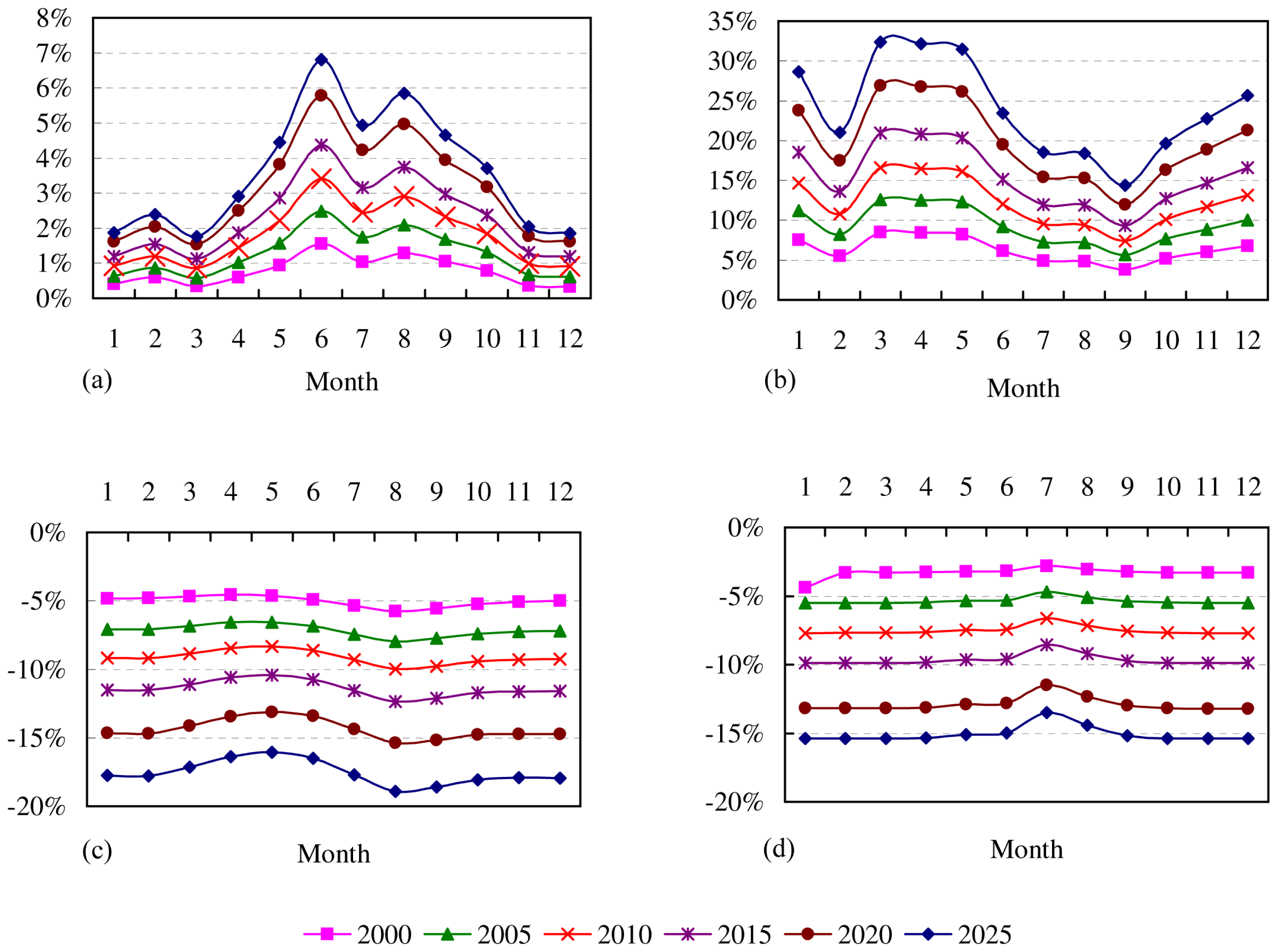Monitoring and Predicting Land-use Changes and the Hydrology of the Urbanized Paochiao Watershed in Taiwan Using Remote Sensing Data, Urban Growth Models and a Hydrological Model
Abstract
:1. Introduction
2. Methods and Materials
2.1. Study watershed and data
2.2. Land-use images and classification
2.3. SLEUTH model
- Spontaneous new growth, which simulates random urbanization of land.
- New spreading centers, which simulate development of new urban centers.
- Edge growth, which represents the outward spread of existing urban centers.
- Road-influenced growth, which simulates the influence of the transportation network on development patterns.
2.4. CLUE-s model
2.5. Landscape Metrics
2.6. Hydrological Model
3. Results
3.1. Land use change modeling
3.2. Historical and predicted land-use patterns
3.3. Historical and predicted hydrology change induced by land-use changes
4. Discussions
4.1. Land-use change drivers and modeling
4.2. land-use patterns of historical and predicted land-uses
4.3. Impact of land-use changed on hydrology
4. Conclusions
Acknowledgments
References
- Xian, G.; Crane, M.; Steinwand, D. Dynamic modeling of Tampa Bay urban development using parallel computing. Computers and Geosciences 2005, 31(7), 920–928. [Google Scholar]
- Fang, S.; Gertner, G.Z.; Sun, Z.; Anderson, A.A. The impact of interactions in spatial simulation of the dynamics of urban sprawl. Landscape and Urban Planning 2005, 73(4), 294–306. [Google Scholar]
- Herold, M.; Goldstein, N.C.; Clarke, K.C. The spatiotemporal form of urban growth: measurement, analysis and modeling. Remote Sensing of Environment 2003, 86(3), 286–302. [Google Scholar]
- Batty, M.; Howes, D. Remote sensing and urban analysis. In Predicting temporal patterns in urban development from remote imagery; Donnay, J.P., Barnsley, M.J., Longley, P.A., Eds.; Taylor and Francis: London and New York, 2001; pp. 185–204. [Google Scholar]
- Jensen, J.R.; Cowen, D.C. Remote sensing of urban/suburban infrastructure and socio-economic attributes. Photogrammetric Engineering and Remote Sensing 1999, 65(5), 611–622. [Google Scholar]
- Herold, M.; Menz, G.; Clarke, K.C. Remote Sensing and Urban Growth Models – Demands and Perspectives. In Regensburger Geographische Schriften, Symposium on remote sensing of urban areas, Regensburg, Germany, June 2001; 2001; 35. [Google Scholar]
- Hietel, E.; Waldhardt, R.; Otte, A. Analysing land-cover changes in relation to environmental variables in Hesse, Germany. Landscape Ecology 2004, 19(5), 473–489. [Google Scholar]
- Lin, Y.P.; Hong, N.M.; Wu, P.J.; Lin, C.J. Modeling and assessing land-use and hydrological processes to future land-use and climate change scenarios in watershed land-use planning. Environmental Geology 2007, 53(3), 623–634. [Google Scholar]
- Agarwal, C.; Green, G.M.; Grove, J.M.; Evans, T.P.; Schweik, C.M. A Review and Assessment of Land-use Change Models: Dynamics of Space, Time, and Human Choice; US Dept. of Agriculture, Forest Service, Northeastern Research Station, 2002; pp. 12–27. [Google Scholar]
- Dietzel, C.; Clarke, K.C. Toward Optimal Calibration of the SLEUTH Land Use Change Model. Transactions in GIS 2007, 11(1), 29–45. [Google Scholar]
- Verburg, P.H.; Veldkamp, A. Projecting land use transitions at forest fringes in the Philippines at two spatial scales. Landscape Ecology 2004, 19(1), 77–98. [Google Scholar]
- Verburg, P.H.; De Nijs, T.C.M.; Ritsema Van Eck, J.; Visser, H.; De Jong, K. A method to analyse neighbourhood characteristics of land use patterns. Computers, Environment and Urban Systems 2004, 28(6), 667–690. [Google Scholar]
- Verburg, P.H.; Ritsema Van Eck, J.R.; De Nijs, T.; Dijst, M.J.; Schot, P. Determinants of land use change patterns in the Netherlands. Environment and Planning B 2004, 31(1), 125–150. [Google Scholar]
- Overmars, K.P.; de Koning, G.H.J.; Veldkamp, A. Spatial Autocorrelation in Multi-scale Land Use Models. Ecological Modelling 2003, 164, 257–270. [Google Scholar]
- Dietzel, C.; Clarke, K.C. Spatial Differences in Multi-Resolution Urban Automata Modeling. Transactions in GIS 2004, 8(4), 479–492. [Google Scholar]
- Jantz, C.A.; Goetz, S.J. Analysis of scale dependencies in an urban land-use-change model. International Journal of Geographical Information Science 2005, 19(2), 217–241. [Google Scholar]
- Syphard, A.D.; Clarke, K.C.; Franklin, J. Using a cellular automaton model to forecast the effects of urban growth on habitat pattern in southern California. Ecological Complexity 2005, 2(2), 185–203. [Google Scholar]
- Verburg, P.H.; Schulp, C.J.E.; Witte, N.; Veldkamp, A. Downscaling of land use change scenarios to assess the dynamics of European landscapes. Agriculture, Ecosystems and Environment 2006, 114(1), 39–56. [Google Scholar]
- Castella, J.C.; Pheng Kam, S.; Dinh Quang, D.; Verburg, P.H.; Thai Hoanh, C. Combining top-down and bottom-up modelling approaches of land use/cover change to support public policies: Application to sustainable management of natural resources in northern Vietnam. Land Use Policy 2007, 24(3), 531–545. [Google Scholar]
- Dietzel, C.; Clarke, K.C. The effect of disaggregating land use categories in cellular automata during model calibration and forecasting. Computers, Environment and Urban Systems 2006, 30(1), 78–101. [Google Scholar]
- Lin, Y.P.; Hong, N.M.; Wu, P.J.; Wu, C.F.; Verburg, P.H. Impacts of land use change scenarios on hydrology and land use patterns in the Wu-Tu watershed in Northern Taiwan. Landscape and Urban Planning 2007, 80(1-2), 111–126. [Google Scholar]
- Turner, M.G.; Gardner, R.H.; O'Neill, R.V. Landscape Ecology in Theory and Practice: Pattern and Process; Springer: New York, 2001; pp. 108–109. [Google Scholar]
- Botequilha Leitao, A.; Ahern, J. Applying landscape ecological concepts and metrics in sustainable landscape planning. Landscape and Urban Planning 2002, 59(2), 65–93. [Google Scholar]
- Corry, R.C.; Nassauer, J.I. Limitations of using landscape pattern indices to evaluate the ecological consequences of alternative plans and designs. Landscape and Urban Planning 2005, 72(4), 265–280. [Google Scholar]
- Legesse, D.; Vallet-Coulomb, C.; Gasse, F. Hydrological response of a catchment to climate and land use changes in Tropical Africa: case study South Central Ethiopia. Journal of Hydrology 2003, 275(1-2), 67–85. [Google Scholar]
- Haverkamp, S.; Fohrer, N.; Frede, H.G. Assessment of the effect of land use patterns on hydrologic landscape functions: a comprehensive GIS-based tool to minimize model uncertainty resulting from spatial aggregation. Hydrological Processes 2005, 19(3), 715–727. [Google Scholar]
- Fohrer, N.; Haverkamp, S.; Frede, H.G. Assessment of the effects of land use patterns on hydrologic landscape functions: development of sustainable land use concepts for low mountain range areas. Hydrological Processes 2005, 19(3), 659–672. [Google Scholar]
- Haith, D.A.; Shoemaker, L.L. Generalized watershed loading functions for stream flow nutrients. Water Resources Bulletin 1987, 23(3), 471–478. [Google Scholar]
- Clarke, K.C. Land Transition Modeling With Deltatrons. Proc. The Land Use Modeling Conference, Sioux Falls, SD, June 1997.
- Claggett, P.R.; Jantz, C.A.; Goetz, S.J.; Bisland, C. Assessing Development Pressure in the Chesapeake Bay Watershed: An Evaluation of Two Land-Use Change Models. Environmental Monitoring and Assessment 2004, 94(1), 129–146. [Google Scholar]
- Verburg, P.H.; Soepboer, W.; Veldkamp, A.; Limpiada, R.; Espaldon, V.; Mastura, S.S.A. Modeling the Spatial Dynamics of Regional Land Use: The CLUE-S Model. Environmental Management 2002, 30(3), 391–405. [Google Scholar]
- Elkie, P.C.; Rempel, R.S.; Carr, A.P. Patch analyst user's manual. A tool for quantifying landscape structure. Ont. Min. Natur. Resour. Northwest Sci. and Technol. Thunder Bay, Ont. Technical Manual TM-002 1999, 4–12. [Google Scholar]
- Mcgarigal, K.; Marks, B.J. FRAGSTATS: Spatial Pattern Analysis Program for Quantifying Landscape Structure; Portland, Or.; US Dept. of Agriculture, Forest Service, Pacific Northwest Research Station, 1995; pp. 38–53. [Google Scholar]
- Carlile, D.W.; Skalski, J.R.; Batker, J.E.; Thomas, J.M.; Cullinan, V.I. Determination of ecological scale. Landscape Ecology 1989, 2(4), 203–213. [Google Scholar]
- Gibson, C.C.; Ostrom, E.; Ahn, T.K. The concept of scale and the human dimensions of global change: a survey. Ecological Economics 2000, 32(2), 217–239. [Google Scholar]
- Scanlon, B.R.; Reedy, R.C.; Stonestrom, D.A.; Prudic, D.E.; Dennehy, K.F. Impact of land use and land cover change on groundwater recharge and quality in the southwestern US. Global Change Biology 2005, 11(10), 1577–1593. [Google Scholar]
- Bormann, H. Impact of spatial data resolution on simulated catchment water balances and model performance of the multi-scale TOPLATS model. Hydrology and Earth System Sciences 2006, 10(2), 165–179. [Google Scholar]









| Statistical matrices | Description |
|---|---|
| Compare | Ratio of modeled population (PM) of urban pixels to the observed population of urban pixels (PO) for the final control year: Compare = PM(final year)/PO(final year). If PM>PO, then Compare =1 − PM(final year)/ PO(final year). |
| Population | Least squares regression score for modeled urban pixels compared with actual urban pixels for each control year. |
| Edges | Least squares regression score for modeled urban edge count compared to actual urban edge count for the control years |
| Clusters | Least squares regression score for modeled urban clustering compared to known urban clustering for the control years |
| Lee-Sallee | Ratio of the intersection to the union of the simulated (SMi) and the actual (SOi) urban areas for each control year (i) averaged over all control years (N): |
| F-Match | Ratio of the number of pixels categorized into correct land-use (C) to the sum of the number of pixels categorized into correct land-use (C) and wrong land-use (W): F-Match = ∑(C)/(C + W) |
| Variable1 | Forest | Built-up land | Cultivated land | Grassland | Bare land |
|---|---|---|---|---|---|
| DTransport | 6.4E-04***2 | N/A2 | -9.0E-04*** | -7.9E-02**2 | -1.5E-03** |
| DEM | 9.3E-04*** | N/A | -4.5E-04*2 | N/A | N/A |
| Slope | 9.4E-02*** | -2.0E-02 | -6.7E-02*** | -3.9E-02*** | -4.1E-02*** |
| DRiver | -1.1E-04*** | N/A | 4.1E-04*** | 4.2E-04*** | N/A |
| DBuild | 5.1E-03*** | -2.8E-01*** | -1.1E-03*** | N/A | -8.9E-04 |
| DZone | N/A | N/A | 6.0E-05** | 3.0E-04*** | N/A |
| SDr | 2.1E-01*** | N/A | N/A | N/A | -1.2*** |
| SErosin | 8.0E-01*** | N/A | 2.1*** | 4.5*** | 4.1** |
| PDens | -4.0E-05*** | 2.0E-05 | -3.6E-04*** | N/A | -1.4E-03*** |
| Constant | -1.5 | 6.2 | -1.1 | -5.2 | -4.7 |
| ROC3 | 0.9 | 1.0 | 0.7 | 0.7 | 0.8 |
| Landscape matrices | SLEUTH model | CLEU-s model |
|---|---|---|
| NP | 72273.8 | 14953.1 |
| MPS | 2.2 | 0.2 |
| MSI | 0.000 | 0.001 |
| AWMSI | 1.1 | 1.0 |
| TE | 11996.6 | 1193.7 |
| MPFD | 0.00003 | 0.00003 |
| MNN | 171.1 | 21.9 |
| IJI | 0.6 | 1.4 |
| CLUE-S model (n=25) | SLEUTH model (n=25) | t-test | |
|---|---|---|---|
| NP | 1540.28 | 1219.56 | 11.125*** |
| MPS | 6.4296 | 8.1432 | -10.473*** |
| TE | 784777.60 | 696614.40 | 8.308*** |
| MSI | 1.282 | 1.2848 | -1.247 |
| AWMSI | 13.3212 | 12.4448 | 4.953*** |
| MPFD | 1.04 | 1.04 | N/A |
| MNN | 96.08 | 114.728 | -9.948*** |
| IJI | 53.3824 | 52.8952 | 0.84 |
© 2008 by MDPI Reproduction is permitted for noncommercial purposes.
Share and Cite
Lin, Y.-P.; Lin, Y.-B.; Wang, Y.-T.; Hong, N.-M. Monitoring and Predicting Land-use Changes and the Hydrology of the Urbanized Paochiao Watershed in Taiwan Using Remote Sensing Data, Urban Growth Models and a Hydrological Model. Sensors 2008, 8, 658-680. https://doi.org/10.3390/s8020658
Lin Y-P, Lin Y-B, Wang Y-T, Hong N-M. Monitoring and Predicting Land-use Changes and the Hydrology of the Urbanized Paochiao Watershed in Taiwan Using Remote Sensing Data, Urban Growth Models and a Hydrological Model. Sensors. 2008; 8(2):658-680. https://doi.org/10.3390/s8020658
Chicago/Turabian StyleLin, Yu-Pin, Yun-Bin Lin, Yen-Tan Wang, and Nien-Ming Hong. 2008. "Monitoring and Predicting Land-use Changes and the Hydrology of the Urbanized Paochiao Watershed in Taiwan Using Remote Sensing Data, Urban Growth Models and a Hydrological Model" Sensors 8, no. 2: 658-680. https://doi.org/10.3390/s8020658





